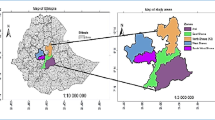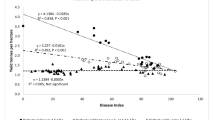Abstract
The production of chickpea, an important legume grown all over the world, is severely constrained by ascochyta blight, which can cause up to a 100% yield loss. The most reliable, economical, and effective management techniques for this disease is fungicide treatments and host plant resistance. The objectives of the present study were to evaluate chickpea varieties and fungicide application intervals against chickpea ascochyta blight epidemics; identify the most effective fungicide application time interval; and determine the association of ascochyta blight incidence and severity with yield and yield components of chickpea. The study was carried out in two hotspot regions (Dhera and Dugda) during the main growing seasons of 2020 and 2021. Three chickpea varieties (Dhera, Habru, and Mariye) and four fungicide spray schedules (Mancozeb 80% WP at a rate of 2.5 a.i. kg/ha) were utilized as treatments, and they were treated up until the crop reached full physiological maturity. Twelve treatments were set up in a factorial arrangement with three replicates using a randomized complete block design (RCBD). Both the Gompertz model and the logistic model were used to assess dependent variables under various treatments. For the disease progres rate under various treatments, the slope of the regression line was determined. The results of the data analysis revealed considerable variations between the treatments. Fungicide application time schedule, varieties, and their interactions had substantial effects on ascochyta blight. The Mariye variety had the highest incidence (100%) and severity (70.68%) of ascochyta blight, with 100% yield loss seen from untreated plots, whereas the Dhera variety experienced the lowest incidence (6.35%) and severity (11.01%) following fungicide management on the 7th day of the interval. The analysis of the means revealed that applying fungicide at intervals of 7 and 14 days was an effective strategy to reduce the severity, incidence, and AUDPC of ascochyta blight. This strategy led to the highest yield of seeds per pod, pods per plant, and grain yield when compared to the untreated plots and the plot treated at a 21-day interval. To handle polycyclic outbreaks of the disease successfully, both the logistic and Gompertz models were used. The study's extent of variety resistance was enough to control the disease in two cropping seasons and locations. This investigation led us to the conclusion that a program to control ascochyta blight of chickpea in Ethiopia may include the integration of fungicides and resistant varieties. Additionally, methods for integrated management of the Ethiopian ascochyta blight on chickpeas must be developed.



Similar content being viewed by others
References
Ahmad, H. U., Chang, K. F., Hwang, S. F., Gossen, B. D., Howard, R. J., & Warkentin, T. D. (2006). Component of disease resistance in desi and kabuli chickpea varieties against ascochyta blight. Plant Pathology Journal, 5(3), 336–342.
Akem, C. (1999). Ascochyta blight of chickpea: Present status and future priorities. International Journal of Pest Management, 45, 131–137.
Amin, M., & Melkamu, F. (2014). Management of ascochyta blight (Ascochyta rabiei) in Chickpea using a new fungicide. Research in Plant Sciences, 2(1), 27–32.
Aslam, M., Ahmad, K., Amir Maqbool, M., Bano, S., Zaman, Q. U., & Mohyuddin Talha, G. (2014). Assessment of adaptability in genetically diverse chickpea varieties (Cicer arietinum L.) based on different physio-morphological standards under ascochyta blight inoculation. International Journal of Advanced Research, 2(2), 245–255.
Bayaa, B., Udupa, S.M., Baum, M., Malhotra, R.S., Kabbabeh, S. (2004). Pathogenic variability in Syrian isolates of ascochyta rabiei. In Proceedings of the 5th European Conference on Grain Legumes; Dijon, France. p. 306.
Berger, R. D. (1981). Comparison of the Gompertz and logistic equations to describe plant disease progress. Phytopathology, 71, 716–719.
Bretag, T. W., Keane, P. J., & Price, T. V. (2006). The epidemiology and control of ascochyta blight in field peas: a review. Australian Journal of Agricultural Research, 57, 883–902.
Chongo, G., & Gossen, B. (2001). Effect of plant age on resistance to Ascochyta rabiei in chickpea. Canadian Journal of Plant Pathology, 23, 358–363.
Chongo, G., & Gossen, G. P. (2003). Foliar fungicide to manage ascochyta blight (Ascochyta rabiei) of chickpea. International Canadian Journal of Plant Pathology, 25, 135–142.
Chongo, G., Buchwaldt, L., Gossen, B. D., Lafond, G. P., May, M. E., Johnson, E. N., & Hogg, T. (2003). Foliar fungicides to manage ascochyta blight (Ascochyta rabiei) of chickpea in Canada. Canadian Journal of Plant Pathology, 25, 135–142.
Chongo, G., Gossen, B. D., Buchwaldt, L., Adhikari, T., & Rimmer, S. R. (2004). Genetic diversity of ascochyta rabiei in Canada. Plant Disease, 88, 4–10.
FAO. (2018). World food and agriculture: Statistical pocketbook 2018. FAO.
FAO. (2019). FAOSTAT database. Retrieved October 2021 from https://www.fao.org/faostat/en/
Fininsa, C. (2022). Plant Disease Epidemiology and Management: Factors of plant disease epidemics and their monitoring (1stedn). School of Plant Sciences, College of Agriculture and Environmental Sciences, Haramaya University, Haramaya, Ethiopia.
Gan, Y. T., Siddique, K. H. M., MacLeod, W. J., & Jayakumar, P. (2006). Management options for minimizing the damage by ascochyta blight (Ascochyta rabiei) in chickpea (Cicer arietinum L.). Field Crops Research, 97, 121–134. https://doi.org/10.1016/j.fcr.2005.10.002
Geletu, B., Yedeta, A. (1994). Breeding chickpea for resistance to drought. International Symposium on Pulse Research. April 2–6, 1994 (pp. 145 -146), New Delhi, India
Ilarslan, H., & Dolar, F. S. (2002). Histological and ultra-structural changes in leaves and stems of resistant and susceptible chickpea cultivars to Ascochyta rabiei. Journal of Phytopathology (Berlin), 150, 340–348.
Joshi, P. K., Parthasarathy Rao, P., Gowda, C. L. L., Jones, R. B., Silim, S. N., Saxena, K.B., Kumar, J. (2001). The world chickpea and pigeon pea economies: facts, trends, and outlook. Patancheru 502 324, Andhra Pardesh, India. International Crops Research Institute for the Semi-Arid Tropics. 68: 443-6. Order code BOE 030.
Kaiser, W. J., & Hannan, R. M. (1988). Seed transmission of ascochyta rabiei in chickpea and its control by seed treatment fungicides. Seed Science and Technology, 16, 625–637.
Khan, M. S. A., Ramsey, M. D., & Scott, E. S. (1999). Host range studies with an Australian isolate of Ascochyta rabiei. Australasian Plant Pathology, 28, 170–173.
Kimber, R. B. E., Shtienberg, D., Ramsey, M. D., & Scott, E. S. (2007). The role of seedling infection in epiphytotics of ascochyta blight on chickpea. European Journal of Plant Pathology, 117, 141–152.
Kimurto, P. K., Mulwa, R. M. S., Towett, B. K., Cheruiyot, E. K., Gangarao, R., Silim, S., Rutto, D. K., Kirui, G., Gaur, P., & Varshney, R. (2013). Screening of chickpea varieties for tolerance to ascochyta blight (Ascochyta rabiei) disease in the dry highlands of Kenya. Journal of Phytopathologia Mediterranean, 52, 611–613.
López-Bellido, F. J., López-Bellido, R. J., Khalil, S. K., & López-Bellido, L. (2008). Effect of planting date on winter kabuli chickpea growth and yield under rainfed Mediterranean conditions. Agronomy Journal, 100, 957–964.
Madden, L., Hughes, G., & Bosch, F. V. D. (2007). Study of Plant Disease Epidemics. American Phytopathological Society.
Millan, T., Clarke, H. J., Siddique, K. H., Buhariwalla, H. K., Gaur, P. M., Kumar, J., Gil, J., Kahl, G., & Winter, P. (2006). Chickpea molecular breeding: New tools and concepts. Euphytica, 147, 81–103.
Nene, Y. L. (1982). A review of ascochyta blight of chickpea. Tropical Pest Management, 28, 61–70.
NMSA. (2020, 2021). National Meteorological Services Agency. Agro Meteorological
Pande, S., Sharma, M., Gaur, P. M., Gowda, C. L. L. (2010). Host Plant Resistance to Ascochyta Blight of Chickpea. Information Bulletin No. 82. Patancheru 502 324, Andhra Pradesh, India: International Crops Research Institute for the Semi-Arid Tropics. 40 pp. ISBN 978–92–9066–525–0. Order code: IBE 082.
Pande, S., Siddique, K. H. M., Kishore, G. K., Bayaa, B., Gaur, P. M., Goweda, C. L. L., Bretag, T. W., & Crouch, J. H. (2005). Ascochyta blight of chickpea (Cicer arietinum L.): A review of biology, pathogenicity, and disease management. Australian Journal of Agricultural Research, 56, 317–332.
Pande, S., Siddique, K. H. M., Kishore, G. K., Bayaa, B., Gaur, P. M., Gowda, C. L. L., Bretag, T. W., & Crouch, J. H. (2011). Development of screening techniques and identification of new sources of resistance to ascochytablight disease of chickpea. Australasian Plant Pathology, 40, 149–156.
Reddy, M. V., & Singh, K. B. (1984). Evaluation of world collection of chickpea germplasm accession for resistance to ascochyta blight. Plant Disease, 68, 900–901.
SAS Institute Inc. (2007). The SAS system for windows. Version 9.13. SAS Institute Inc. USA.
Shamsi, K., Kobraee, S., & Haghparast, R. (2010). Drought stress mitigation using supplemental irrigation in rainfed chickpea (Cicer arietinum L.) varieties in Kermanshah, Iran. African Journal of Biotechnology, 9(27), 4197–4203.
Shanner, G., & Finney, R. E. (1977). The effect of nitrogen fertilization on the expression of slow-mildewing resistance in Knox wheat. Phytophatology, 70, 1183–1186.
Shtienberg, D., Gamliel E. A., Retig, B., Brener, S., & Dinoor, A. (2005). Significance of preventing primary infections by Didymella rabiei and development of a model to estimate the maturity of pseudothecia. Plant disease, 89, 1027–1034.
Shtienberg, D., Kimber, R. B. E., McMurray, L., & Davidson, J. A. (2006). Optimization of the chemical control of ascochyta blight in chickpea. Australasian Plant Pathology, 35, 715–724. https://doi.org/10.1071/AP06069
Shtienberg, D., Vintal, H., Brener, S., & Retig, B. (2000). Rational management of Didymellarabiei in chickpea by integration of genotype resistance and post-infection application of fungicides. Phytopathology, 90, 834–842.
Tekeoglu, M., Santra, D., Kaiser, W. J., & Muehlbauer, F. J. (2000). Ascochyta blight resistance inheritance in three chickpea recombinant inbred line populations. Crop Science, 40, 1251–1256.
Trapero-Casas, A., & Kaiser, W. J. (1992). Influence of temperature, wetness period, plant age, and inoculum concentration on infection and development of ascochyta blight of chickpea. Phytopathology, 82, 589–596.
Van Der Plank, J. E. (1963). Plant disease: Epidemic and control (p. 206). Academic Press.
Wheeler, B. E. (1969). An Introduction to Plant Diseases (p. 374). Wiley and Sons.
Zewdie, A. (2018). Assessment of chickpea seed borne disease with special reference to ascochyta blight (Didymella rabiei) in Central Ethiopia. International Journal of Life Sciences, 6(3), 707–712.
Acknowledgements
This study was supported by a PhD grant from the Modernizing Ethiopian Research on Crop Improvement (MERCI) initiative and the Ethiopian Institute of Agricultural Research (EIAR). We appreciate the financial assistance from the MERC and EIAR.
Author information
Authors and Affiliations
Corresponding author
Ethics declarations
Conflict of interest
An article titled "Temporal Epidemics and Management of Ascochyta Blight (Ascochyta rabiei) of Chickpea (Cicer arietinum L.) in Central Rift Valley, Ethiopia" has been enclosed and submitted to the European Plant Pathology journal for consideration for publication. We neither engage in nor have any financial affiliation with any of the organizations or entities mentioned in this book. Additionally, we have no competing interests to disclose.
Rights and permissions
Springer Nature or its licensor (e.g. a society or other partner) holds exclusive rights to this article under a publishing agreement with the author(s) or other rightsholder(s); author self-archiving of the accepted manuscript version of this article is solely governed by the terms of such publishing agreement and applicable law.
About this article
Cite this article
Addisu, S., Fininsa, C., Bekeko, Z. et al. Temporal epidemics and management of ascochyta blight (Ascochyta rabiei) of chickpea (Cicer arietinum L.) in Central Rift Valley, Ethiopia. Eur J Plant Pathol (2024). https://doi.org/10.1007/s10658-024-02828-x
Accepted:
Published:
DOI: https://doi.org/10.1007/s10658-024-02828-x




